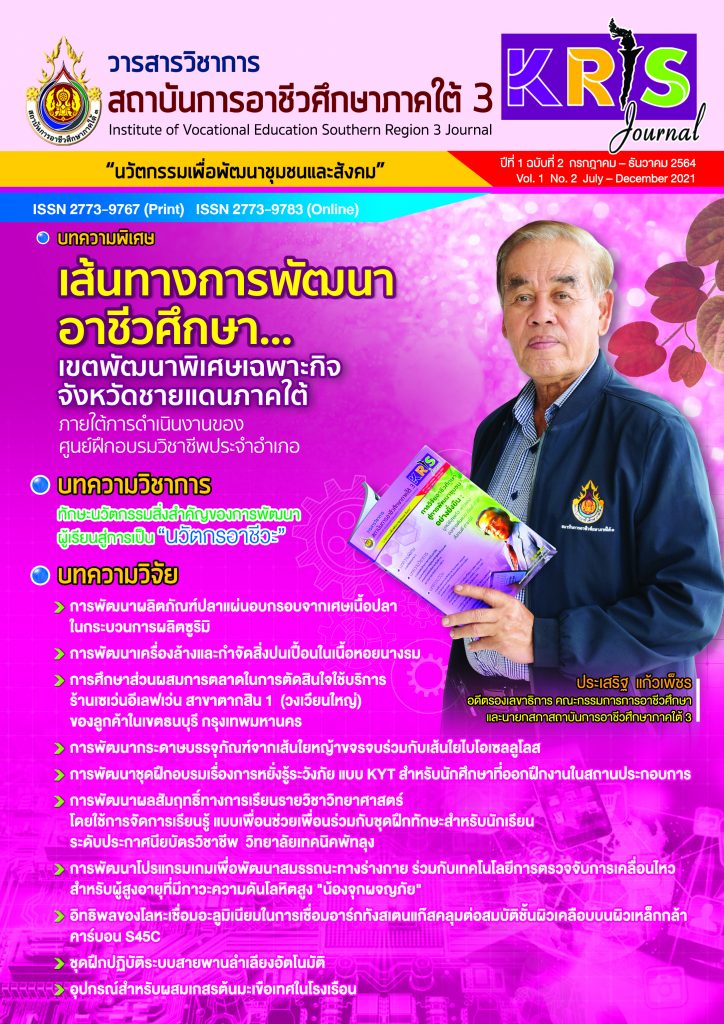Development of Oyster Cleaning Machine to Wash Meat and Its Contaminants
Keywords:
Oyster, Cleaners and contaminant machine, BacteriaAbstract
The purposes of this research were to: 1) develop an oyster cleaning machine to wash meat and its contaminants, 2) determine the performance of the oyster cleaning machine to wash meat and its contaminants, 3) find the efficiency of the oyster cleaning machine and 4) study the satisfaction of users on the oyster cleaning machine. The sample groups in this research consisted of 15 oyster farmers derived by purposive sampling technique using the machine to wash 400 oysters from Ban Don Bay area, Surat Thani Province and 15 oyster consumers in Surat Thani Province derived by convenient sampling technique. The research
instruments were the experiment record form and the satisfaction questionnaire. The statistics used in this research included mean ( ) and standard deviation (S.D.).
The results of the research showed that the developed oyster cleaning machine
to wash and remove contaminants in oyster meat was used with the street food vendors for washing 200 oysters at a time. The machine consists of a water spray system to wash and clean while the oysters open their shells. The roof is designed to have a 150 Watt flexible solar roof for energy, and more importantly, the used water can be recycled by an automated process. When testing the performance of the oyster cleaning machine on removing contaminants in oyster meat, it was found that the total bacterial content of oysters before rinsing was 19,000 CFU/g and post-wash was 7,600 CFU/g, with 60% lower post-wash pathogens than before rinsing, which was consistent with the research hypothesis.The efficiency of the oyster cleaner and contamination removal machine was higher than the typical cleaners and contamination removal machines. After washing, it was found that
Vibrio was less than 87.34%, Escherichia coli was less than 51.14, and Fecal coliform was less than 70.94 which was consistent with the research hypothesis. Moreover, the users reported very high satisfaction with the oyster cleaning machine conforming the research hypothesis.
References
สุรชาติ วิชัยดิษฐ์. (2559). การประเมินความเสี่ยงของหอยนางรมจากแหล่งเลี้ยงในอ่าวบ้านดอน อำเภอกาญจนดิษฐ์ จังหวัดสุราษฎร์ธานี (วิทยานิพนธ์ วท.ม. การจัดการเทคโนโลยีอุตสาหกรรมเกษตร), มหาวิทยาลัยสงขลานครินทร์, สงขลา.
อนันต์ ตันสุตะพานิช. (2551), การออกแบบเครื่องมือกลเพื่อบำบัดน้ำและเลน ลดการใช้พลังงานและสารเคมี ในฟาร์มหมุนเวียนน้ำระบบปิด, กองวิจัยและพัฒนาการเพาะเลี้ยงสัตว์น้ำชายฝั่ง: กรมประมง.
พงษ์เทพ วิไลพันธ์, อรษา สุดเธียรกุล, มณีย์ กรรณรงค์, ธีรยา สรรพวรพงษ์, ประทุมวัลย์ เจริญพร, ดาวริน สุขเกษม. (2556). หอยนางรมปลอดภัย สถานการณ์และแนวทางบริหารจัดการตลอดห่วงโซ่ การผลิต กรณีศึกษาจังหวัดสุราษฎร์ธานี (รายงานผลการวิจัย), สำนักงานกองทุนสนับสนุนการวิจัย, กรุงเทพฯ : บริษัท ซีโน พับลิชชิ่ง แอนด์ แพคเกจจิ้ง จำกัด.
ลดาพรรณ แสงคล้าย, ดวงดาว วงศ์สมมาตร์, อารุณี ศรพรหม, สมภพ วัฒนมณ, มัณฑนา พันธ์บัวหลวง รัชฎาพร สุวรรณรัตน. (2560). เกณฑ์คุณภาพทางจุลชีววิทยาของอาหารและภาชนะสัมผัสอาหาร ฉบับที่ 3 (พ.ศ. 2560), กระทรวงสาธารณสุข. นนทบุรี: โรงพิมพ์บริษัทพีทู ดีไซน์ แอนด์ พริ้นท์ จำกัด.
Downloads
Published
How to Cite
Issue
Section
License
Copyright (c) 2024 Institute of Vocational Education Southern Region 3 Journal (KRIS Journal)

This work is licensed under a Creative Commons Attribution-NonCommercial-NoDerivatives 4.0 International License.






